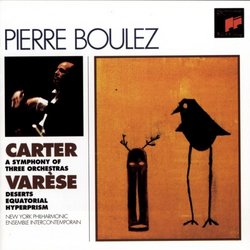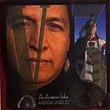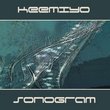| All Artists: Elliott Carter, Edgard Varese, Pierre Boulez, Ensemble InterContemporain, New York Philharmonic, French Radio Choir Title: Elliott Carter: A Symphony of Three Orchestras; Varèse: Deserts; Ecuatorial; Hyperprism Members Wishing: 1 Total Copies: 0 Label: Sony Release Date: 12/5/1995 Genres: Pop, Classical Styles: Vocal Pop, Chamber Music, Historical Periods, Modern, 20th, & 21st Century, Symphonies Number of Discs: 1 SwapaCD Credits: 1 UPC: 074646833421 |
Search - Elliott Carter, Edgard Varese, Pierre Boulez :: Elliott Carter: A Symphony of Three Orchestras; Varèse: Deserts; Ecuatorial; Hyperprism
 | Elliott Carter, Edgard Varese, Pierre Boulez Elliott Carter: A Symphony of Three Orchestras; Varèse: Deserts; Ecuatorial; Hyperprism Genres: Pop, Classical
|
Larger Image |
CD DetailsSimilar CDs
|
CD ReviewsGood Disc for Headphones. Karl Henzy | 12/22/1998 (4 out of 5 stars) "Carter's Symphony for Three Orchestras is quite simply one of the most spectacular works of orchestral music of this century. If you listen to it with headphones, you can actually here the music being passed around the three orchestras. It's almost too much for the brain--with dazzling, virtuoso riffs coming from all sides and overlapping to make a dense, rich tapestry. Some stunning individual moments emerge, too--such as the trumpet solo emulating the seagull's flight at the beginning (the work is based on Harte Crane's epic poem The Bridge), or the bell-like ringing on the piano towards the end, or the tremendous orchestral thunderclaps. The Varese works are a nice addition--Hyperprism is from V's early violent noise/music experiments, while the other works are from his later, more atmospheric-mysterious phase. A good disc, all in all. Five stars if it were all Carter." Fantastic Carter and Varese, strangely combined R. Hutchinson | a world ruled by fossil fuels and fossil minds | 08/05/2005 (5 out of 5 stars) "Though the combination of Carter and Varese is odd, I can't see giving this disc, part of the superb Sony PIERRE BOULEZ series, anything less than 5 stars. It is the only available recording of Carter's "Symphony for Three Orchestras" (1976 -- 15'41), and the Varese is uniformly excellent as well. It strikes me as simultaneously bizarre and marvelous that Carter's work, which was written to celebrate the American Bicentennial, with a grant from the National Endowment for the Arts, was commissioned by Pierre Boulez! Boulez was then the conductor of the New York Philharmonic. The piece is based on Hart Crane's poem "The Bridge." It is a tragic vision of America, and the music begins in the highest registers, and descends until, with a series of violent crashes, it ends in the lowest registers with tuba and double bass. In the SYMPHONY, like Stockhausen's GRUPPEN, Carter divides the orchestra into three groups, and each group plays four movements, so the result is 12 overlapping movements in all. The recording of the NYP is from 2/22/77, and who better than Boulez to produce a crystal-clear rendering of this teeming complexity! There is only one thing that I would change, and that is that the piece is too short. Here's a fantastic quote from Carter from the liner notes: "I do not want to give the impression of a simultaneous motion in which everybody's part is coordinated like a goose step. I do not want to write the kind of music that just marches on and marches off. I want it to seem like a crowd of people, or like waves on the sea -- all things that signify a much more fluid, and, to me, more human way of living." There is an entire disc of Varese in this series, and so what is included here is really Part II -- the lead composition in the other disc (Part I) is "Arcana" (see my review). This material is just as good, and while some complain that Boulez left the electronics out of "Deserts," I say enjoy it as is -- if you didn't know about the electronics, you'd think it sounded great, which it does." A tape piece without a tape? R. Hutchinson | 12/08/1999 (3 out of 5 stars) "I too wish this disc were all Carter. The Varese is a little disappointing. (The disc is also short.) The "Deserts" recorded here inexplicably removes the tape parts that (usually) give it its distinctive flavor. Those interested in Varese may therefore want to look instead to the Chailly set on London."
|

 Track Listings (4) - Disc #1
Track Listings (4) - Disc #1


